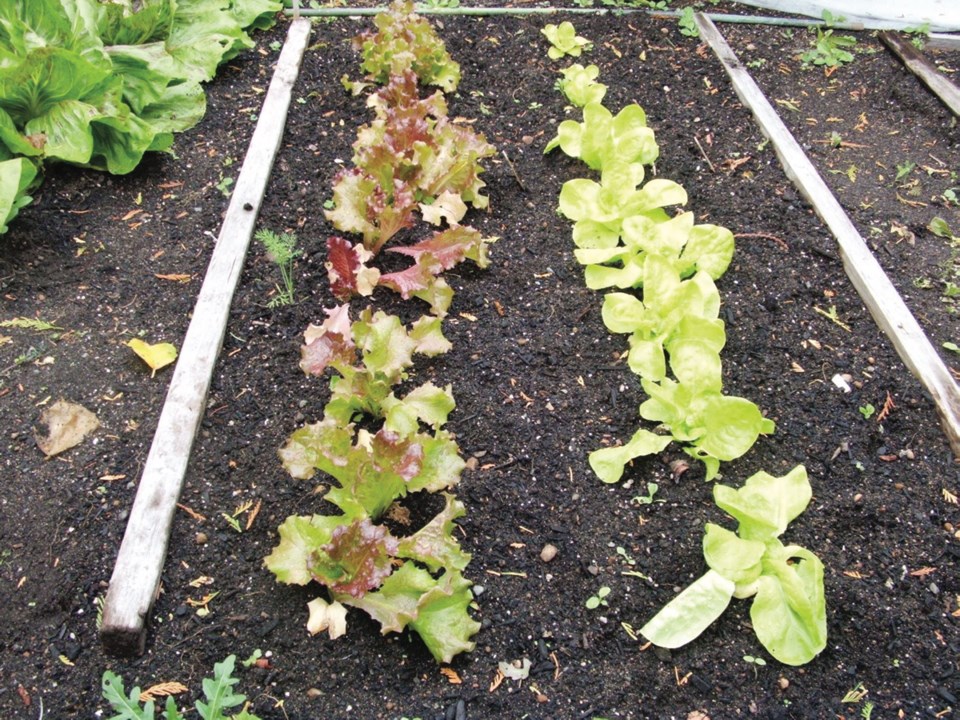Dear Helen: Do you seed lettuce indoors or outdoors? Why, and how often?
S.L.
I seed lettuce almost exclusively indoors, and thin the seedlings well to allow nicely bushed out transplants to form. I tuck them into the garden here and there, wherever there is some space beside or around larger, more long-term plantings. I seed every few weeks from February through early August. Seeding indoors avoids outdoor weather that is too cold or too hot for successful germination outdoors.
Seeds can also be sown outdoors and will yield fully formed lettuces if the seedlings are thinned adequately and cool, lightly shaded sites are used for sowing in hot, dry summer weather. For full, luscious lettuces, the soil needs to be humus-rich and easy to keep consistently moist.
I sometimes make the last lettuce sowing of the season, for fall and winter use, an outdoor one, around Aug. 10. I thin out the rows as soon as seedlings are large enough to handle easily. I make sure the planting is a convenient width for covering with protective tunnelling during periods of harsh weather.
Gardeners all have their own preferences in lettuces and other leafy greens. I relish full, individual heads and rosettes of butter, romaine and leaf lettuces, while others may opt for growing plantings of small leaves, using mixtures of lettuces and other leafy greens called mescluns, which are simply seeded in garden plots and containers for blends of small leaves to cut for salads. Most mescluns will regrow to give two or three cuttings.
Dear Helen: What are the black and white striped insects that have emerged from the ground in our garden? They look like small wasps, but are not at all aggressive.
D.M.
They are most likely hover (syrphid) flies, one of the most beneficial insects in our gardens. They overwinter as pupae in the soil or under fallen leaves, and emerge early in the spring to feed on nectar and pollen from the first flowers. The eggs they lay among aphids hatch into larvae that feed voraciously on the aphids.
The flies are fascinating to watch as they hover like tiny helicopters over flowers. They as particularly attracted to yellow flowers. Other good nurturers of hover flies are sweet alyssum and cilantro.
Dear Helen: What vegetable plantings should be covered with insect netting or floating row cover to keep them free of pest infestation?
W.G.
I cover carrots, beets and spinach, onions, and cabbage family vegetables — but only because I know from experience that these plantings will be badly damaged by insect pests.
Though the pests that target these plantings are commonly occurring ones, they are not a major problem in every garden. Also, a garden can be free of a pest for years before it shows up to ruin a crop. I grew beautiful bulb onions uncovered for 25 years in my current garden before the year when every single plant wilted. The forming bulbs were squishy and destroyed by the feeding of onion fly maggots within them.
The plantings I cover attract specific types of small flies that lay eggs in the soil beside plants. The eggs hatch into larvae (maggots) that feed on the plant roots.
Carrot rust fly maggots create tunnels filled with rusty brown matter in the roots. Cabbage fly maggots burrow into the plant roots, causing them to wilt and stunting the plants. Covering cabbage family plants also prevents common white cabbage butterflies from laying eggs on them. The eggs develop into pale green, velvety caterpillars that chew holes in leaves and feed on cauliflower and broccoli florets.
I cover beets and spinach to keep the leaves from being marred by the beet and spinach leaf miner fly, whose larvae burrow between upper and lower leaf surfaces, causing brownish “mined” areas where feeding has occurred. Leaf miner damage is seen also on chard. Where infestations are light, removing affected leaves is usually enough to adequately control this pest.
All these flies produce at least two generations each growing season. The first generation, in spring, is usually the more populous.
GARDEN EVENTS
Native plant meeting. The Native Plant Study Group will meet on Thursday, 7 p.m. in Room D-288 of UVic’s MacLaurin building. Dr. Tara Martin, UBC professor, will speak about the role of deer in the native landscape. Non-member drop-in fee by donation. Students free. Parking cost $3. npsg.ca.
Plant sale. Cairnsmore Place Volunteer Gardeners are hosting their annual plant sale on Saturday, from 9 a.m. to 12 p.m. at 250 Cairnsmore St. in Duncan.



